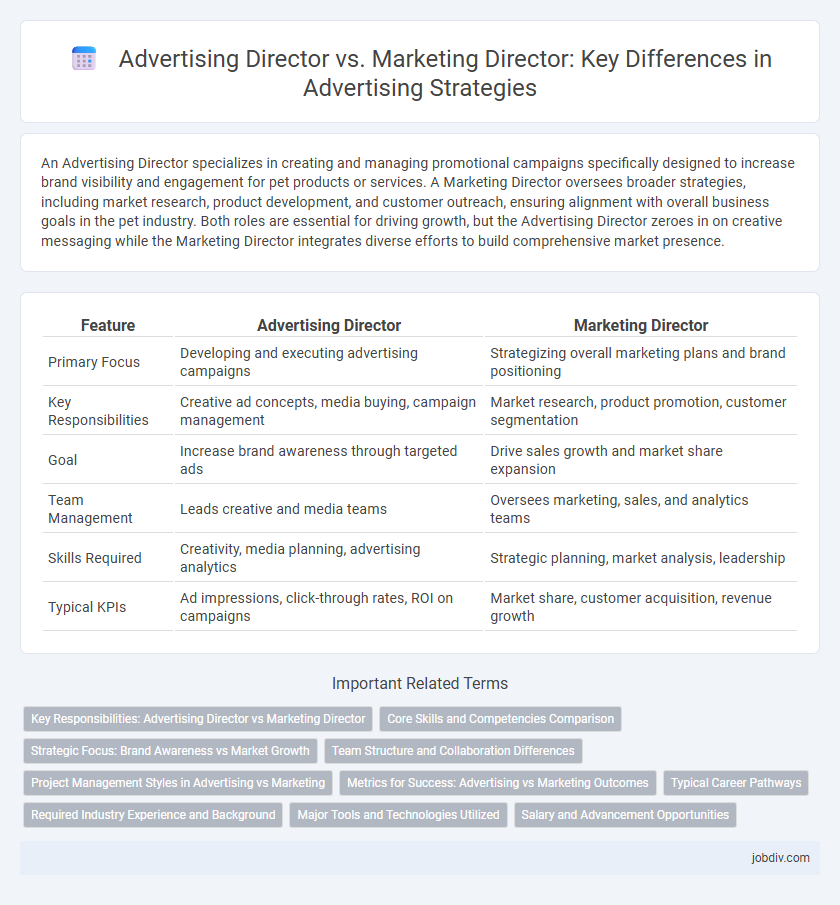An Advertising Director specializes in creating and managing promotional campaigns specifically designed to increase brand visibility and engagement for pet products or services. A Marketing Director oversees broader strategies, including market research, product development, and customer outreach, ensuring alignment with overall business goals in the pet industry. Both roles are essential for driving growth, but the Advertising Director zeroes in on creative messaging while the Marketing Director integrates diverse efforts to build comprehensive market presence.
Table of Comparison
| Feature | Advertising Director | Marketing Director |
|---|---|---|
| Primary Focus | Developing and executing advertising campaigns | Strategizing overall marketing plans and brand positioning |
| Key Responsibilities | Creative ad concepts, media buying, campaign management | Market research, product promotion, customer segmentation |
| Goal | Increase brand awareness through targeted ads | Drive sales growth and market share expansion |
| Team Management | Leads creative and media teams | Oversees marketing, sales, and analytics teams |
| Skills Required | Creativity, media planning, advertising analytics | Strategic planning, market analysis, leadership |
| Typical KPIs | Ad impressions, click-through rates, ROI on campaigns | Market share, customer acquisition, revenue growth |
Key Responsibilities: Advertising Director vs Marketing Director
An Advertising Director specializes in creating and overseeing ad campaigns, managing creative teams, and ensuring brand messaging aligns across media channels to drive audience engagement and brand recognition. A Marketing Director focuses on broader strategic planning, market research, product positioning, and coordinating cross-functional initiatives to increase market share and revenue growth. Both roles require leadership and budget management, but the Advertising Director is more creative and campaign-oriented, whereas the Marketing Director handles overall market strategy and business objectives.
Core Skills and Competencies Comparison
Advertising Directors excel in creative campaign development, brand messaging, and media planning, emphasizing visual storytelling and consumer engagement. Marketing Directors possess strengths in market analysis, strategic planning, and data-driven decision-making, focusing on broader business growth and customer segmentation. Both roles require leadership and communication skills, but Advertising Directors prioritize creative direction while Marketing Directors focus on cross-channel marketing integration and ROI optimization.
Strategic Focus: Brand Awareness vs Market Growth
An Advertising Director primarily drives brand awareness by crafting compelling campaigns that enhance visibility and audience engagement across diverse media channels. In contrast, a Marketing Director focuses on market growth through comprehensive strategies encompassing product development, customer segmentation, and sales optimization. Both roles synergize to elevate brand presence and expand market share, but their core strategic objectives differ significantly.
Team Structure and Collaboration Differences
Advertising Directors typically lead creative teams focused on campaign development, including copywriters, graphic designers, and media planners, while Marketing Directors oversee broader cross-functional teams that include sales, product development, and customer analytics. Advertising Directors collaborate closely with creative departments and external agencies to align messaging and visuals, whereas Marketing Directors coordinate with multiple departments to integrate branding, market research, and customer engagement strategies across channels. The team structure under Advertising Directors is more specialized and project-based, whereas Marketing Directors manage a more diverse, strategically driven team aimed at overall market growth.
Project Management Styles in Advertising vs Marketing
Advertising Directors often adopt a creative and deadline-driven project management style, emphasizing campaign originality and visual impact to engage target audiences effectively. Marketing Directors prioritize a data-driven, analytical approach, coordinating cross-functional teams to align projects with broader business goals and market trends. The divergence in management styles reflects the advertising focus on creative execution versus marketing's strategic planning and performance measurement.
Metrics for Success: Advertising vs Marketing Outcomes
Advertising Directors prioritize metrics such as click-through rates, ad impressions, and conversion rates to gauge campaign effectiveness and audience engagement. Marketing Directors focus on broader metrics including customer acquisition cost, lifetime value, brand awareness, and market share growth to evaluate overall brand performance. Both roles utilize data analytics, but Advertising Directors concentrate on immediate campaign ROI while Marketing Directors assess long-term strategic impact.
Typical Career Pathways
Advertising Directors typically progress from roles such as Creative Director, Copywriter, or Media Planner, gaining expertise in campaign creation, brand messaging, and media buying. Marketing Directors often rise through positions like Product Manager, Market Research Analyst, or Brand Manager, emphasizing strategic market analysis, customer segmentation, and product positioning. Both career paths demand strong leadership, analytical skills, and a deep understanding of consumer behavior to drive business growth effectively.
Required Industry Experience and Background
Advertising Directors typically require extensive experience in creative campaign development, brand messaging, and media planning within the advertising industry, emphasizing skills in client management and visual storytelling. Marketing Directors need a broader background in market research, consumer behavior analysis, product positioning, and cross-channel strategy execution, often with experience spanning advertising, digital marketing, and sales. Both roles demand a strong understanding of industry trends, but Advertising Directors focus more on creative execution, while Marketing Directors prioritize overall market growth and revenue generation.
Major Tools and Technologies Utilized
Advertising Directors primarily leverage creative software such as Adobe Creative Suite, media buying platforms like Google Ads and Facebook Ads Manager, and data analytics tools including Nielsen and Comscore for campaign performance tracking. Marketing Directors employ comprehensive marketing automation systems like HubSpot and Marketo, customer relationship management (CRM) software such as Salesforce, and SEO tools including SEMrush or Ahrefs to optimize brand strategy and customer engagement. Both roles utilize data visualization tools like Tableau or Power BI to translate complex data into actionable insights supporting strategic decisions.
Salary and Advancement Opportunities
Advertising Directors typically earn a median salary ranging from $95,000 to $140,000 annually, while Marketing Directors often command higher salaries, averaging between $100,000 and $160,000 depending on industry and company size. Advancement opportunities for Advertising Directors are typically within creative departments, leading to roles such as Chief Creative Officer, whereas Marketing Directors have broader corporate advancement potential, including Chief Marketing Officer positions and executive leadership roles. Salary growth and career progression in both fields depend heavily on proven strategic impact, leadership skills, and the ability to drive brand revenue.
Advertising Director vs Marketing Director Infographic

 jobdiv.com
jobdiv.com